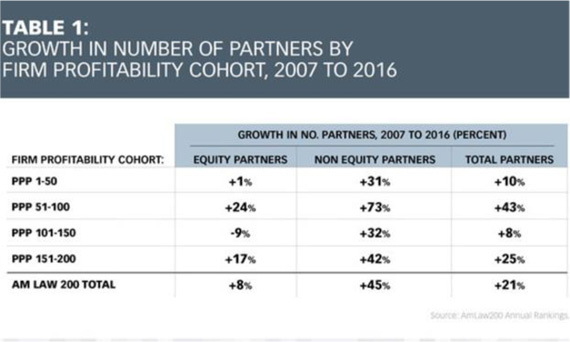Law.com Subscribers SAVE 30%
Call 855-808-4530 or email [email protected] to receive your discount on a new subscription.
How Many Excess Partners Does Your Firm Have?
It is widely recognized that Big Law has surplus partner capacity. In a recent Altman Weil survey, over two-thirds of firm leaders reported their equity partners were not sufficiently busy; nearly 80% said the same of nonequity partners. What is less well recognized is just how massive this surplus has become, how unevenly it is spread across firms in different profitability cohorts, and what it portends for when the next downturn hits.
The last time partners were fully utilized was in 2007, the year before the great recession hit. In aggregate, the number of partners has grown by 21%. Growth of equity partners has been relatively modest (only 8%) while that of nonequity partners has been dramatic (45%). It is noteworthy that the highest profit-per-equity-partner (PPP). PPP in the 50 highest profit firms (PPP 1-50) have barely grown their equity ranks and that the PPP in the 101-150 highest profit firms actually shrank theirs. The second 50 highest profit firms (PPP 51-100) stand out as having grown both their equity and nonequity ranks considerably ahead of the other profitability cohorts.

This premium content is locked for Entertainment Law & Finance subscribers only
ENJOY UNLIMITED ACCESS TO THE SINGLE SOURCE OF OBJECTIVE LEGAL ANALYSIS, PRACTICAL INSIGHTS, AND NEWS IN ENTERTAINMENT LAW.
- Stay current on the latest information, rulings, regulations, and trends
- Includes practical, must-have information on copyrights, royalties, AI, and more
- Tap into expert guidance from top entertainment lawyers and experts
Already a have an account? Sign In Now Log In Now
For enterprise-wide or corporate acess, please contact Customer Service at [email protected] or 877-256-2473

Major Differences In UK, U.S. Copyright Laws
This article highlights how copyright law in the United Kingdom differs from U.S. copyright law, and points out differences that may be crucial to entertainment and media businesses familiar with U.S law that are interested in operating in the United Kingdom or under UK law. The article also briefly addresses contrasts in UK and U.S. trademark law.

The Article 8 Opt In
The Article 8 opt-in election adds an additional layer of complexity to the already labyrinthine rules governing perfection of security interests under the UCC. A lender that is unaware of the nuances created by the opt in (may find its security interest vulnerable to being primed by another party that has taken steps to perfect in a superior manner under the circumstances.

Strategy vs. Tactics: Two Sides of a Difficult Coin
With each successive large-scale cyber attack, it is slowly becoming clear that ransomware attacks are targeting the critical infrastructure of the most powerful country on the planet. Understanding the strategy, and tactics of our opponents, as well as the strategy and the tactics we implement as a response are vital to victory.

Removing Restrictive Covenants In New York
In Rockwell v. Despart, the New York Supreme Court, Third Department, recently revisited a recurring question: When may a landowner seek judicial removal of a covenant restricting use of her land?

Legal Possession: What Does It Mean?
Possession of real property is a matter of physical fact. Having the right or legal entitlement to possession is not "possession," possession is "the fact of having or holding property in one's power." That power means having physical dominion and control over the property.

